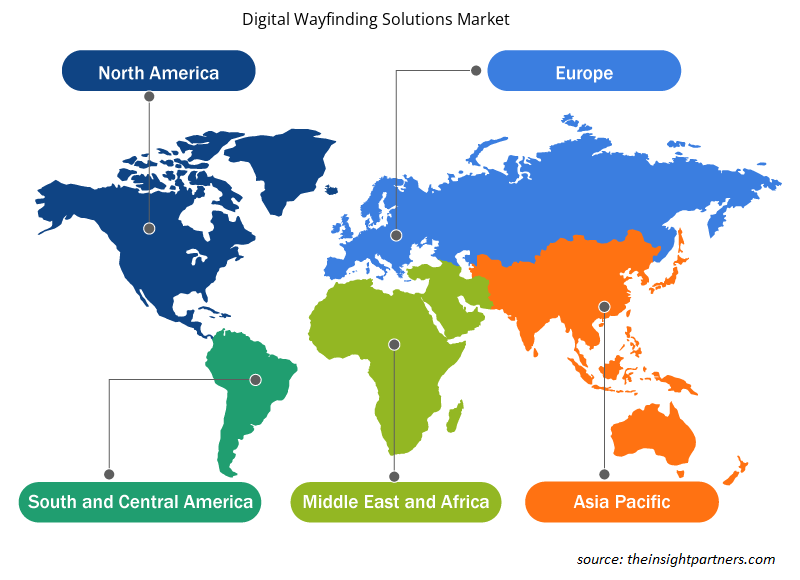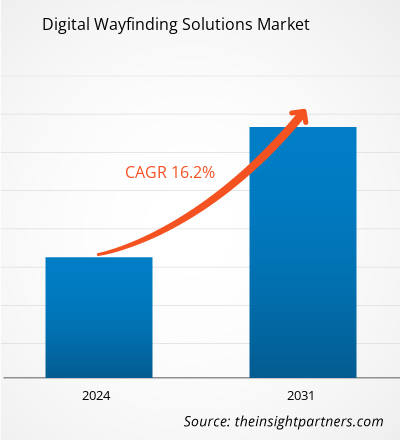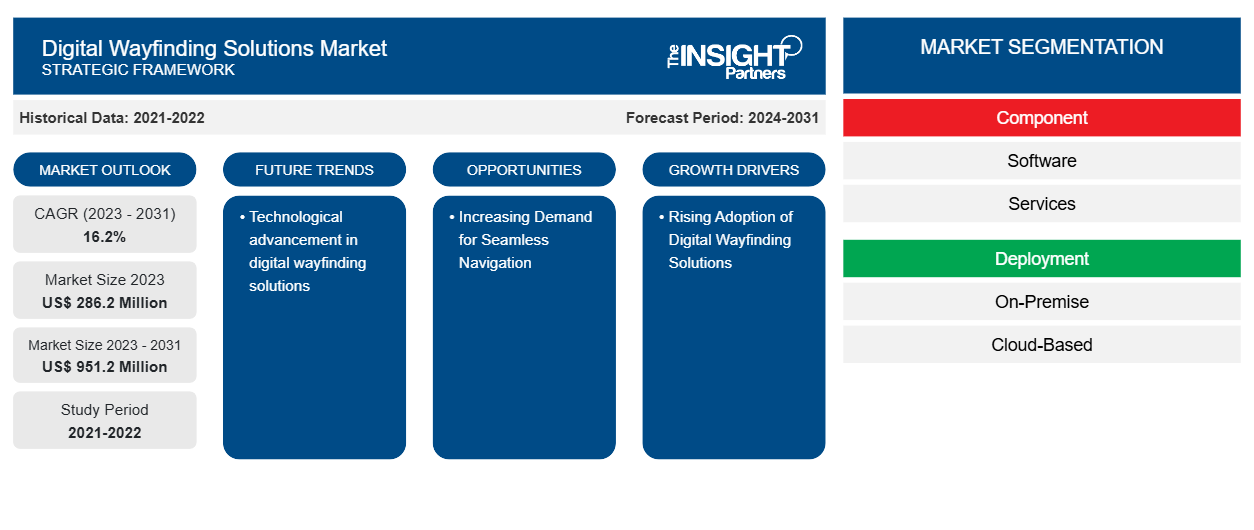Le marché des solutions d’orientation numérique devrait atteindre 951,2 millions de dollars américains d’ici 2031, contre 286,2 millions de dollars américains en 2023. Le marché devrait enregistrer un TCAC de 16,2 % au cours de la période 2023-2031. Les progrès technologiques dans les solutions d’orientation numérique devraient rester une tendance clé du marché.
Analyse du marché des solutions d'orientation numérique
Les systèmes d'orientation numériques fournissent aux entreprises d'excellentes analyses et informations sur les données. Ces données comprennent des informations sur les heures de pointe, les itinéraires les plus fréquentés et les visites fréquentes dans les zones. Dans un centre commercial, le système peut suivre le trafic piétonnier pour localiser les zones à fort trafic, ce qui permet aux entreprises de placer stratégiquement des présentoirs promotionnels ou d'optimiser l'agencement des magasins pour augmenter la visibilité et les ventes. De plus, le suivi du comportement des utilisateurs dans les systèmes d'orientation numérique permet aux entreprises de comprendre comment les individus interagissent avec le système. Dans un environnement de musée, le suivi des préférences des utilisateurs pour les visites d'expositions peut informer les visiteurs de leurs préférences. Ces informations aident les conservateurs à créer de futures expositions pour compléter les sujets populaires et améliorer l'expérience des visiteurs.
Aperçu du marché des solutions d'orientation numérique
L'orientation numérique utilise des technologies telles que des cartes interactives, des écrans tactiles et des applications mobiles pour guider les individus dans la découverte de leur chemin dans des environnements intérieurs ou extérieurs. Elle a considérablement amélioré les méthodes d'orientation traditionnelles en utilisant la technologie pour fournir des solutions de navigation en temps réel, dynamiques et personnalisées. Contrairement à la signalisation statique , les écrans numériques fournissent des informations actualisées en temps réel, permettant aux utilisateurs d'accéder aux directions les plus précises et les plus exactes. L'aéroport utilise des systèmes d'orientation numérique avancés pour offrir une navigation transparente aux passagers dans les terminaux, les portes et les installations. Bien qu'il soit l'un des aéroports les plus fréquentés au monde, l'adoption de ces systèmes de pointe vise à améliorer la communication globale et l'efficacité opérationnelle.
Personnalisez ce rapport en fonction de vos besoins
Vous bénéficierez d'une personnalisation gratuite de n'importe quel rapport, y compris de certaines parties de ce rapport, d'une analyse au niveau des pays, d'un pack de données Excel, ainsi que de superbes offres et réductions pour les start-ups et les universités.
-
Obtenez les principales tendances clés du marché de ce rapport.Cet échantillon GRATUIT comprendra une analyse de données, allant des tendances du marché aux estimations et prévisions.
Moteurs et opportunités du marché des solutions d'orientation numérique
L'adoption croissante des solutions d'orientation numérique favorise le marché
Les solutions d'orientation numérique sont utilisées dans de nombreux secteurs et environnements. Parmi les cas d'utilisation les plus courants, on trouve les aéroports, les centres commerciaux, les hôpitaux et les établissements de santé, les établissements d' enseignement, les centres d'exposition et de congrès, les musées et les institutions culturelles, et bien d'autres encore. Les aéroports utilisent des solutions d'orientation numérique pour aider les voyageurs à se déplacer dans les terminaux, à trouver leurs portes d'embarquement, à localiser les zones de récupération des bagages et à accéder aux équipements de l'aéroport. Ces solutions incluent souvent des informations sur les vols en temps réel, les temps d'attente aux points de contrôle de sécurité et des informations sur les services tels que les restaurants et les magasins. Les solutions d'orientation numérique fournissent des informations sur le comportement des utilisateurs, comme les itinéraires populaires, les zones fréquemment visitées et les habitudes de navigation. Ces données peuvent être analysées pour obtenir des informations sur les préférences des utilisateurs, le flux de trafic et l'utilisation globale des installations, permettant aux organisations de prendre des décisions basées sur les données et d'optimiser leurs espaces.
Demande croissante pour une navigation fluide
L'orientation numérique offre une navigation sans effort, des indications claires et un moyen pratique pour les utilisateurs de se déplacer dans les aéroports, les centres commerciaux, les hôpitaux, etc. Une orientation claire et concise améliore l'expérience globale de l'utilisateur en réduisant le stress, la frustration et la confusion. Qu'il s'agisse de se déplacer dans une gare très fréquentée ou dans un campus d'entreprise tentaculaire, les systèmes de signalisation intuitifs offrent tranquillité d'esprit et confiance aux visiteurs et aux employés. Il est difficile de se déplacer dans un centre commercial tentaculaire, mais les cartes intérieures peuvent simplifier le processus. Les clients peuvent facilement localiser les magasins de leur choix, localiser les équipements tels que les toilettes et les escaliers mécaniques et tracer l'itinéraire le plus court vers leur destination. Qu'il s'agisse d'un visiteur novice ou régulier, les cartes intérieures offrent un parcours fluide et sans stress dans l'agencement complexe du centre commercial. À mesure que la technologie évolue, l'intégration de solutions d'orientation numérique et d'affichages interactifs améliorera encore les capacités et l'efficacité des systèmes de signalisation d'orientation, inaugurant une nouvelle ère de navigation fluide pour tous.
Analyse de segmentation du rapport sur le marché des solutions d'orientation numérique
Les segments clés qui ont contribué à l’élaboration de l’analyse du marché des solutions d’orientation numérique sont les composants, le déploiement et l’utilisateur final.
- En fonction des composants, le marché des solutions d’orientation numérique est segmenté en logiciels et services.
- En termes de déploiement, le marché est segmenté en sur site et basé sur le cloud.
- En termes d’application, le marché est segmenté en aéroports, commerces de détail, soins de santé, musées et autres.
Analyse des parts de marché des solutions d'orientation numérique par zone géographique
La portée géographique du rapport sur le marché des solutions d'orientation numérique est principalement divisée en cinq régions : Amérique du Nord, Asie-Pacifique, Europe, Moyen-Orient et Afrique, et Amérique du Sud et centrale. La Cleveland Clinic est un centre médical remarquable aux États-Unis qui a mis en œuvre un système de haute technologie pour aider les patients et les visiteurs à se déplacer sur le campus complexe. Ce système d'orientation numérique utilise des écrans tactiles interactifs et des applications mobiles pour fournir aux patients des instructions étape par étape vers les cliniques, les services et les chambres des patients.
Aperçu régional du marché des solutions d'orientation numérique
Les tendances et facteurs régionaux influençant le marché des solutions d’orientation numérique tout au long de la période de prévision ont été expliqués en détail par les analystes d’Insight Partners. Cette section traite également des segments et de la géographie du marché des solutions d’orientation numérique en Amérique du Nord, en Europe, en Asie-Pacifique, au Moyen-Orient et en Afrique, ainsi qu’en Amérique du Sud et en Amérique centrale.

- Obtenez les données régionales spécifiques au marché des solutions d'orientation numérique
Portée du rapport sur le marché des solutions d'orientation numérique
| Attribut de rapport | Détails |
|---|---|
| Taille du marché en 2023 | 286,2 millions de dollars américains |
| Taille du marché d'ici 2031 | 951,2 millions de dollars américains |
| Taux de croissance annuel composé mondial (2023-2031) | 16,2% |
| Données historiques | 2021-2022 |
| Période de prévision | 2024-2031 |
| Segments couverts |
Par composant
|
| Régions et pays couverts |
Amérique du Nord
|
| Leaders du marché et profils d'entreprises clés |
|
Densité des acteurs du marché des solutions d'orientation numérique : comprendre son impact sur la dynamique des entreprises
Le marché des solutions d'orientation numérique connaît une croissance rapide, tirée par la demande croissante des utilisateurs finaux en raison de facteurs tels que l'évolution des préférences des consommateurs, les avancées technologiques et une plus grande sensibilisation aux avantages du produit. À mesure que la demande augmente, les entreprises élargissent leurs offres, innovent pour répondre aux besoins des consommateurs et capitalisent sur les tendances émergentes, ce qui alimente davantage la croissance du marché.
La densité des acteurs du marché fait référence à la répartition des entreprises ou des sociétés opérant sur un marché ou un secteur particulier. Elle indique le nombre de concurrents (acteurs du marché) présents sur un marché donné par rapport à sa taille ou à sa valeur marchande totale.
Les principales entreprises opérant sur le marché des solutions d'orientation numérique sont :
- Acquérir le numérique
- Cliquez sur Grafix
- ConnectedSign
- SOLUTIONS D'ORIENTATION NUMÉRIQUE
- Jarma Technologies LLP
- MétroClick
Avis de non-responsabilité : les sociétés répertoriées ci-dessus ne sont pas classées dans un ordre particulier.

- Obtenez un aperçu des principaux acteurs du marché des solutions d'orientation numérique
Actualités et développements récents du marché des solutions d'orientation numérique
Le marché des solutions d'orientation numérique est évalué en collectant des données qualitatives et quantitatives après des recherches primaires et secondaires, qui comprennent des publications d'entreprise importantes, des données d'association et des bases de données. Quelques-uns des développements du marché des solutions d'orientation numérique sont répertoriés ci-dessous :
- 22Miles Inc. a annoncé aujourd'hui le lancement de Digital Signage Ready (DSR), une collection de logiciels et de services prêts à l'emploi qui facilitent la configuration et le déploiement des expériences d'affichage numérique les plus populaires. (Source : 22Miles Inc., juillet 2021)
- Acquire Digital a lancé une solution d'orientation et d'annuaire numérique pour le prochain salon des épiceries. La plate-forme interactive d'orientation et de navigation intérieure d'Acquire Digital, leader du secteur, sera utilisée pour aider les participants à naviguer dans le salon, à explorer les événements et à découvrir d'autres documents d'exposition essentiels. (Source : Acquire Digital, septembre 2021)
Rapport sur le marché des solutions d'orientation numérique : couverture et livrables
Le rapport « Taille et prévisions du marché des solutions d’orientation numérique (2021-2031) » fournit une analyse détaillée du marché couvrant les domaines ci-dessous :
- Taille et prévisions du marché des solutions d'orientation numérique aux niveaux mondial, régional et national pour tous les segments de marché clés couverts par le périmètre
- Tendances du marché des solutions d'orientation numérique ainsi que dynamiques du marché telles que les facteurs déterminants, les contraintes et les opportunités clés
- Analyse détaillée des cinq forces de PEST/Porter et SWOT
- Analyse du marché des solutions d'orientation numérique couvrant les principales tendances du marché, le cadre mondial et régional, les principaux acteurs, les réglementations et les développements récents du marché
- Analyse du paysage industriel et de la concurrence couvrant la concentration du marché, l'analyse de la carte thermique, les principaux acteurs et les développements récents pour le marché des solutions d'orientation numérique
- Profils d'entreprise détaillés
- Analyse historique (2 ans), année de base, prévision (7 ans) avec TCAC
- Analyse PEST et SWOT
- Taille du marché Valeur / Volume - Mondial, Régional, Pays
- Industrie et paysage concurrentiel
- Ensemble de données Excel
Rapports récents
Rapports connexes
Témoignages
Raison d'acheter
- Prise de décision éclairée
- Compréhension de la dynamique du marché
- Analyse concurrentielle
- Connaissances clients
- Prévisions de marché
- Atténuation des risques
- Planification stratégique
- Justification des investissements
- Identification des marchés émergents
- Amélioration des stratégies marketing
- Amélioration de l'efficacité opérationnelle
- Alignement sur les tendances réglementaires























 Obtenez un échantillon gratuit pour - Marché des solutions d'orientation numérique
Obtenez un échantillon gratuit pour - Marché des solutions d'orientation numérique